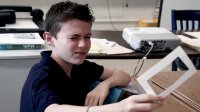Integrated Studies Research Review
Editor's Note: This article was originally written by Vanessa Vega, with subsequent updates made by the Edutopia staff.
Integrated studies is a great way to get students more involved in school; it enhances motivation, problem-solving skills, content knowledge, and deeper understanding of connections across subjects. In Edutopia’s integrated studies research review, discover seven key approaches in effective curriculum integration, get our specific recommendations on evidence-based practices and programs, learn about pitfalls to avoid, and dig into an annotated bibliography of studies supporting the efficacy of integrated studies practices.
What Is Integrated Studies?
Integrated studies involves the combination of two or more subjects in a lesson, project, classroom, or curriculum. Teachers can draw interdisciplinary connections by making relationships between different subjects explicit, and/or by working with other teachers in teams across subjects. For example, science and English language arts teachers may have students read multiple texts about a scientific issue that is relevant to their lives or community, then ask them to evaluate the evidence and reasoning of the various texts in a collaborative discussion and write a persuasive essay in which they take a stance on the issue.
Teachers can also make connections between subjects by using different disciplinary approaches to solve a problem. For example, a teacher may assign students the task of designing or constructing a bridge while learning about the history of famous bridges, bridges in poetry and literature, as well as mathematical principles and engineering processes involved in building bridges.
Teachers can also integrate students’ community and/or career interests by co-creating curricula that addresses themes that students would like to address, using content standards as a guide. For example, students may be required to master a specific set of content standards by addressing a need in their community, by conducting independent research on a career-related interest, and/or by participating in an internship program.
When compared to traditional instructional methods, effective practices and programs in integrated studies can improve multiple indicators:
- Participation, motivation, and interest in learning (Catterall, Dumais, and Hampden-Thompson, 2012; Goldschmidt and Jung, 2010; Guthrie, Klauda, and Ho, 2013; Hughes, Bailey, and Karp, 2002; Mac Iver, 1990; Smithrim and Upitis, 2005; Upitis, 2011)
- Critical-thinking and problem-solving skills (Billig, 2010; Furco, 2010)
- Academic achievement (Barry, 2010; Blair, 2009; Borman, Hewes, Overman, and Brown, 2003; Burnaford and Scripp, 2012; Catterall et al., 2012; Cervetti, Pearson, Barber, Hiebert, and Bravo, 2007; Chand O’Neal, 2014; Furco and Root, 2010; Goldschmidt and Jung, 2010; Guthrie et al., 2013; Klemmer, Waliczek, and Zajicek, 2005; Menzer, 2015; Nelson, 2001; Hendrickson and Oklahoma A+ Schools, 2010; Romance and Vitale, 2012a, 2012b; Satchwell and Loepp, 2002; Smith and Motsenbocker, 2005; Smithrim and Upitis, 2005; Walker, McFadden, Tabone, and Finkelstein, 2011; WestEd)
- Attendance, graduation, and college attainment rates (Catterall et al., 2012; Furco, 2010; Hughes et al., 2002)
- Feelings of connection among teachers and team spirit among students (Mac Iver, 1990; Smithrim and Upitis, 2005
The next section describes seven successful approaches to integrated studies:
- Science and Literacy
- Science and the Environment
- Science, Technology, Engineering, and Math
- Financial Literacy
- Arts Integration Across All Subjects
- Internships and Service-Learning
- Second-Language Learning and Global Competency
Continue to the next section of the Integrated Studies Research Review, Evidence-Based Practices and Programs.
Integrated Studies Research Table of Contents:
- Definition and Outcomes
- Evidence-Based Practices and Programs
- Avoiding Pitfalls
- Annotated Bibliography
